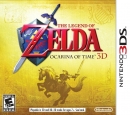kn said:
Sqrl said:
It saddens me how many times I have explained the reasons why 1:1 is possible and yet people still believe otherwise.
To put it simply, the accelerometers in the Wii-Mote are plenty sensitive to pick up, track, and relay the data in a timely fashion. The accelerometers track input in real-time, the next step is obviously encapsulation and transmission via Bluetooth technology, and since Bluetooth is a radio frequency technology the signal moves at the speed of light. And then it is processed back in the Wii and displayed on screen.
The amount of time it takes for the information to leave the Wii-Mote and arrive at the Wii is negligible. The real potential for a slow down is in the processing of the data and this is also the area where there is the most potential for improvements. Something I think most people miss completely is that the Wii CPU is easily capable of 729,000,000 operations per second. I have to wonder how many operations people believe it would take to interpret the data...if we assume a ridiculously large number like 10,000 operations we can see that at that rate the Wii would be capable of interpreting the data 60 times a second while only utilizing 0.0823% of its clock cycles to do so. Realize that 10,000 operations is unreasonable to begin with but also that things can be streamlined beyond what I am mentioning here and that this is only meant to illustrate a more realistic understanding of the situation and not to explain it in absolute detail.
In any case, working with what I know from experience: The Wii-Mote can track the data required and it can get it to the Wii with time to calculate its effect as to not have a noticeable delay. With a decent algorithm the Wii can easily handle it without a performance hit in AI or Physics even.
Note: Everything up to this point has been an explanation for the Wii's capability of tracking the rotation and movement of the Wii-mote.
Now the hard part: Tracking the Wii-Mote as I just talked about is very easy and very trivial from a technological and design standpoint. The difficulty is in trying to track the person and what they do. And what I mean is this. If a person pushes the remote forward it would be tracked similarly (not identical) to how the remote would track someone actually moving their body (and thus the remote) forward. Distinguishing these two actions is key to achieving parity between the relative positions of you and the wii-mote and the character and their weapon.
I want to state that again because it is important to understand: Here in reality we have YOU and the WII-MOTE. In order to avoid an awkward situation the game needs to keep the relative positions on screen of the CHARACTER and WEAPON similar to the relative positions of YOU and the WII-MOTE. Or to illustrate a strange situation, imagine you are playing a game and you drop the wii-mote but the character on screen appears to quickly bend down and touch the ground. This type of disparity between what happened in reality and what is shown on screen can make 1:1 controls awkward, this is why they must be done properly or they will suck...to be blunt.
I won't attempt to recreate it here, but in the past on this site I have laid out a series of controls that I believe would work very well for providing extremely fine controls for a game involving sword combat (or similar styles) without making it impossibly hard or boring for the player.
The basic idea is to recognize that the player does not always need to have precise 1:1 control. Instead we would give them the option to use more abstract control scheme when they don't need fine control but allow them to quickly and easily switch to the 1:1 controls when they are needed. |
My understanding of the Wii remote is that it uses two technologies -- one is an accelerometer todetect speed of motion and it uses Infrared light to detect its position in space. I'm fairly certain that the accelerometers and button mashes can create 1:1 controls quite precisely. I don't think IR can, however. As soon as the on-screen pointer is moved rapidly in a circle, for instance, you will notice the trail begins to be a large polygon rather than a circle. Something in the process -- IR, Wii CPU cycles, the Wiimote's IR controller, etc. is not allowing for 1:1 during rapid movements. I've noticed this in every single game that uses a pointer. I would think that if the latency could be "programmed out", someone would have done it by now. I'm not knocking the Wii... I thoroughly enjoy mine.... BUT, I don't believe the 1:1 light saber game is going to be able to deliver 1:1. MAYBE if enough system resources are dedicated to processing on the Wii side and the Wiimote takes enough samples per second we could see 1:1 but I won't hold my breath. I suspect we will see a massive improvement in the technologies used in the wiimote with the next Nintendo console.... |
The IR is more than capable of drawing a circle, the polygon effect at high speed has more to do with your movements than any technical limitation of the sensor bar or the IR sensor.
As for the delay, I hope we can both agree that there is no meaningful delay in getting the data from the Wii-Mote to the console. This applies to both the IR data and the accelerometer data.
From there it is purely a processing issue. Once we get into the processing issue I am quite confident that the problem is something that is solvable.
I want to state this again, because I am not sure you cought the distinction. The Wii is easily capable of detecting 1:1 movements from both the accelerometers and the IR (with calibration). The problem is in detecting the movement of the body holding the remote. A disconnect in the action taken by the player and the character on screen can make the controls feel clunky. So in that regard, it would take quite an effort to build a game involving 1:1 controls throughout the experience.
Many people mistake this for failing to be capable of 1:1, in reality the data provided is still enough for a clear 1:1 picture, but the interpretation has failed not the technology. I don't think many develoeprs have even begun to take this into account yet to be honest.
What is needed is a recurring period of re-sync where the player doesn't need to think about ry-syncronizing his positions with the TV but rather he just does it. This is very similar to how the Wii Tennis mechanic already works where it is waiting for quick swing motions to trigger a swing. The player automatically swings and resets for the next volley without thinking and the animation faithfully does the same.
What is missing for this to happen in a fully immersive way is an efficient algorithm for detecting the difference between moving your arm to the other side of your body and tracking to take a back hand swing. I thinkthe easy way to do this is to translate the motion on screen until it is determined that a swing is intended and then execute that animation all the while tracking the continued motion of the player and having the game attempt to do its part to re-sync with the player allowing the player to make the minor adjustments. This is the simple way but not the elegant way. I know the scope of this sort of project and given the time frames involved here I think it is not only possible but very likely that the algorithm is still in development. It is not nearly as simple as some might think, but not quite as impossible as others might hope.
Again I want to be clear, the technology is capable of the speed and precision for knowing what the Wii-Mote is doing in 1:1. The hard part, and the part missing right now is the ability to track what the heck the person who is playing is doing.
edit: PS - I know you're not engaging in the discussion simply to "knock the Wii", I hope you don't think I was making this point simply to stir up console drama. This is actually just an aspect of the Wii I have personally worked with (specifically the accelerometers, I have had little experience with the IR) and thus it not only interesting to me but something I have good incite into.


































































